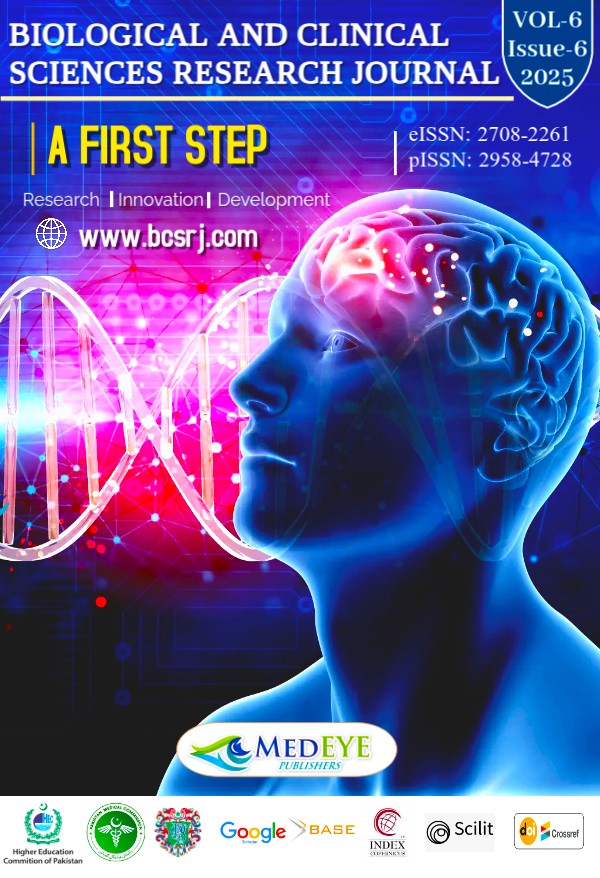Prevalence and Outcome of Incidental Thyroid Nodules Detected on CT Scan
DOI:
https://doi.org/10.54112/bcsrj.v6i6.1960Keywords:
Thyroid Nodule, Incidental Findings, Tomography, X-Ray Computed, Prevalence, Pakistan, Fine-Needle AspirationAbstract
Incidental thyroid nodules (ITNs) are increasingly detected during computed tomography (CT) scans performed for non-thyroid indications. While most ITNs are benign, a subset carries a risk of malignancy, necessitating appropriate evaluation. Data on prevalence and outcomes of ITNs in the Pakistani population remain limited. Objective: To determine the prevalence, radiological characteristics, and outcomes of incidental thyroid nodules detected on CT scans in adults undergoing imaging for unrelated indications. Methods: This descriptive cross-sectional study was conducted at the Department of Diagnostic Radiology, Tertiary Care Hospital Kharian, from March to May 2025. A total of 255 adult patients (18–65 years) undergoing CT scans for non-thyroid indications were included through non-probability consecutive sampling. Patients with a known history of thyroid disease were excluded from the study. Nodule characteristics—including size, location, calcification, margins, and associated lymphadenopathy—were documented. Patients with suspicious nodules underwent further evaluation using ultrasound and/or fine-needle aspiration cytology (FNAC), with histopathological confirmation when indicated. Data were analyzed using SPSS v23, with p < 0.05 considered statistically significant. Results: ITNs were detected in 46 of 255 patients, yielding a prevalence of 18.0%. The mean participant age was 44.8 ± 12.3 years, with a male-to-female ratio of 1.2:1. Most nodules measured <1 cm (45.6%), followed by 1–1.5 cm (30.4%) and >1.5 cm (24.0%). The right lobe was the most common location (52.1%). Calcification was present in 26.1%, and irregular/poorly defined margins in 39.1%. Associated cervical lymphadenopathy was noted in 15.2% of cases. Of the 46 patients, 29 (63.0%) underwent further evaluation; 27 (93.1%) had benign tumors and 2 (6.9%) had malignant tumors. The overall malignancy rate among all ITNs was 4.3%, with a higher, though statistically insignificant, frequency in nodules larger than 1.5 cm in diameter. Conclusion: ITNs were prevalent in nearly one-fifth of patients undergoing CT imaging for unrelated reasons, with most being benign. Larger nodules demonstrated a higher malignancy rate, underscoring the importance of follow-up imaging and, when appropriate, cytological evaluation. Standardized local guidelines tailored to the Pakistani population are crucial for ensuring timely Diagnosis, preventing overtreatment, and optimizing resource utilization.
Downloads
References
Kamakshi K., Krishnamurthy A., Karthik V., Vinodkumar P., Kumar R., & Lakshmipathy K.. Positron emission tomography–computed tomography-associated incidental neoplasms of the thyroid gland. World Journal of Nuclear Medicine 2020;19(01):36-40. https://doi.org/10.4103/wjnm.wjnm_33_19
TURGUT L., KARAKÖSE M., Kocabaş M., Can M., Çordan İ., Kulaksızoğlu M.et al.. The evaluation of the malignancy rate of incidental thyroid nodules detected by FDG PET/CT. Turkish Journal of Endocrinology and Metabolism, 2021; 25(2): 142-150. https://doi.org/10.25179/tjem.2020-80668
Abdelrahman A., Ekladious M., & Nagi M. Incidental thyroid nodules on the COVID-19 positive CT chest. The Egyptian Journal of Hospital Medicine 2022;87(1):1017-1023. https://doi.org/10.21608/ejhm.2022.220737
Rothberger G., Cohen M., Sahay P., Szczepanczyk P., & Islam S.. Method of detection of thyroid nodules: correlation with frequency of fine‐needle aspiration and malignancy rate. Head & Neck 2019;42(2):210-216. https://doi.org/10.1002/hed.25984
Erdoğan M., Korkmaz H., Torus B., Avcı M., Boylubay Ş., Çiriş M.et al.. The role of metabolic volumetric parameters in predicting malignancy in incidental thyroid nodules detected in 18 F-FDG PET/CT scans. Molecular Imaging and Radionuclide Therapy 2021;30(2):86-92. https://doi.org/10.4274/mirt.galenos.2021.75983
Owens C., Fitzhugh A., Harrington K., Paleri V., Sharma B., Shur J.et al.. Incidentally detected 18F-FDG PET-CT-avid thyroid nodules in patients with advanced malignancy: long-term oncological outcomes from a single-centre retrospective cohort. Nuclear Medicine Communications 2023;44(9):810-815. https://doi.org/10.1097/mnm.0000000000001720
Helvacı B., Özdemir D., Turan K., Keskin Ç., İmga N., Dirikoç A.et al.. Incidental thyroid nodules on COVID-19-related thoracic tomography scans: a giant cohort. Hormones 2023;23(2):227-233. https://doi.org/10.1007/s42000-023-00516-9
Wadsley J., Balasubramanian S., Madani G., Munday J., Roques T., Rowe C.et al.. Consensus statement on the management of incidentally discovered FDG avid thyroid nodules in patients being investigated for other cancers. Clinical Endocrinology 2023;101(5):557-561. https://doi.org/10.1111/cen.14905
Ozcan K., Pinar K., Yüksel B., & Bozdogan A.. The modified TI-RADS classification and scoring method for thyroid nodules can be effective for evaluating thyroid incidentalomas on FDG PET-CT imaging. Open Journal of Thyroid Research 2019;2(1):005-008. https://doi.org/10.17352/ojtr.000008
Xu Y., Tang Y., Zhang Q., Zhao Z., Zhao C., Fan P.et al.. Automatic detection of thyroid nodules with a real-time artificial intelligence system in a real clinical scenario and the associated influencing factors. Clinical Hemorheology and Microcirculation 2024;87(4):437-450. https://doi.org/10.3233/ch-242099
Tel B., Kahveci G., Bilgin S., Kurtkulağı Ö., & Kösekli M. Platelet to lymphocyte ratio in differentiation of benign and malignant thyroid nodules. Experimental Biomedical Research 2021;4(2):148-153. https://doi.org/10.30714/j-ebr.2021267978
Helvacı B., Özdemir D., Turan K., Keskin Ç., İmga N., Dirikoç A.et al.. Incidental thyroid nodules on COVID-19-related thoracic tomography scans: a giant cohort. Hormones 2023;23(2):227-233. https://doi.org/10.1007/s42000-023-00516-
Kohlenberg J., Panda A., Johnson G., & Castro M. Radiologic and clinicopathologic characteristics of thyroid nodules with focal 68Ga DOTATATE PET activity. Nuclear Medicine Communications 2021;42(5):510-516. https://doi.org/10.1097/mnm.0000000000001356
Jo J., Kim J., Ryu J., & Lee H. Incidental thyroid nodule on chest computed tomography: application of computed tomography texture analysis in prediction of ultrasound classification. Journal of Computer Assisted Tomography 2022;46(3):480-486. https://doi.org/10.1097/rct.0000000000001286
Sajisevi M., Caulley L., Eskander A., Du Y., Auh E., Karabachev A.et al.. Evaluating the rising incidence of thyroid cancer and thyroid nodule detection modes. Jama Otolaryngology–head & Neck Surgery 2022;148(9):811. https://doi.org/10.1001/jamaoto.2022.1743
Rothberger G., Cohen M., Sahay P., Szczepanczyk P., & Islam S.. Method of detection of thyroid nodules: correlation with frequency of fine‐needle aspiration and malignancy rate. Head & Neck 2019;42(2):210-216. https://doi.org/10.1002/hed.25984
Bertoni D., Schlegel L., Gillmore K., Brill‐Edwards M., Armache M., & Cottrill E. Significance of incidental thyroid findings in a large community‐based lung cancer screening cohort. The Laryngoscope 2024;135(2):964-968. https://doi.org/10.1002/lary.31789
Abdelrahman A., Ekladious M., & Nagi M. Incidental thyroid nodules on the COVID-19 positive CT chest. The Egyptian Journal of Hospital Medicine 2022;87(1):1017-1023. https://doi.org/10.21608/ejhm.2022.220737
Lin D., Arevalo Y., & Lin C. Incidental thyroid nodules found during acute stroke angiography: prevalence, outcomes, and suggested management guidelines. Journal of Diagnostic Medical Sonography 2021;37(5):451-456. https://doi.org/10.1177/87564793211018459
Chooi J., Ravindiran A., & Balasubramanian S.. The influence of incidental detection of thyroid nodule on thyroid cancer risk and prognosis—a systematic review. Clinical Endocrinology 2021;96(2):246-254. https://doi.org/10.1111/cen.14575
Downloads
Published
How to Cite
Issue
Section
License
Copyright (c) 2025 Zara Itrat, Muhammad Babar Khan, Dost Muhammad, . Sanaullah, Adil Qayyum, Ruqqayia Adil

This work is licensed under a Creative Commons Attribution-NonCommercial 4.0 International License.








